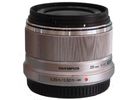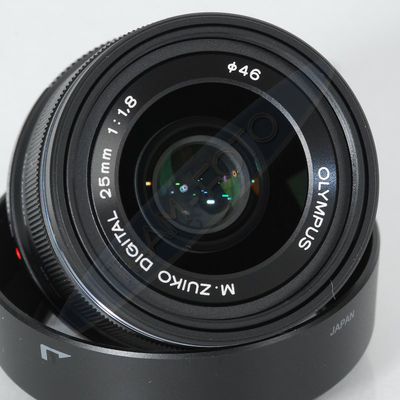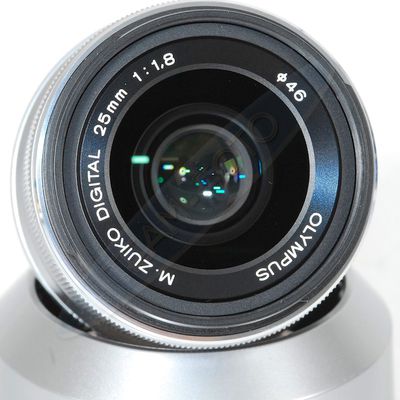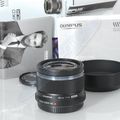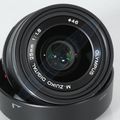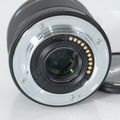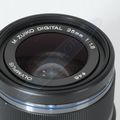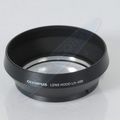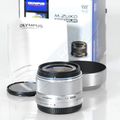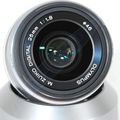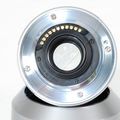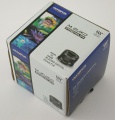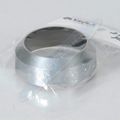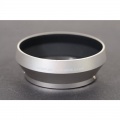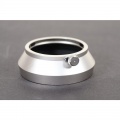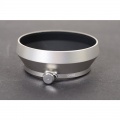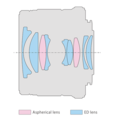M.ZUIKO DIGITAL 25mm F1.8: Unterschied zwischen den Versionen
K (Bilder, Links und Text eingefügt) |
K (Links eingefügt) |
||
| Zeile 12: | Zeile 12: | ||
'''Olympus-Code:''' ES-M2518 | '''Olympus-Code:''' ES-M2518 | ||
| − | == Firmware- | + | == [[Firmware-Update]]s == |
| − | Wie auch bei vielen anderen [[Objektiv]]en liefert [[Olympus]] auch hierzu umfangreiche Firmware- | + | Wie auch bei vielen anderen [[Objektiv]]en liefert [[Olympus]] auch hierzu umfangreiche [[Firmware-Update]]s: |
{| | {| | ||
|bgcolor="#D1E8FF" align="center"|'''Version''' | |bgcolor="#D1E8FF" align="center"|'''Version''' | ||
Version vom 15. April 2024, 19:52 Uhr
Beschreibung
Entspricht einem 50-mm Normalobjektiv in Kleinbildformat - vergleichbar z.B. mit dem Zuiko Auto-S 1:1,8/50 mm Normalobjektiv.
Lt. vieler Nutzermeinungen ein unterschätztes Objektiv, klein, leicht und preiswert - siehe hierzu den Vergleich M.ZUIKO DIGITAL ED 25mm 1:1.2 PRO <-> M.ZUIKO DIGITAL 25mm F1.8 <-> LEICA DG SUMMILUX 1:1,4/25 ASPH. <-> Voigtländer Nokton 25 mm F0.95 bei lensrentals.com. Es kommt zwar nicht (ganz) an die hohen Leistungen des M.ZUIKO DIGITAL ED 25mm 1:1.2 PRO heran, bietet aber - bezogen auf den Einstandspreis - eine insgesamt hervorragende Leistung.
Sucht man also ein relativ lichtstarkes Normalobjektiv für einen "guten Einstandspreis" und kann mit den Gegebenheiten (Kunststofffassung etc.) leben, ist das M.ZUIKO DIGITAL 25mm F1.8 eine ernst zu nehmende Alternative.
Das M.ZUIKO DIGITAL 25mm F1.8 wurde zum Ende des Jahres 2017 mit der PEN F als "kostenlose Beigabe" vermarktet, was den Gebrauchtpreis nach unten katapultierte - wieder mehr ein Grund, hier zuzugreifen.
Olympus-Code: ES-M2518
Firmware-Updates
Wie auch bei vielen anderen Objektiven liefert Olympus auch hierzu umfangreiche Firmware-Updates:
| Version | Veröffentlichung am | Beschreibung |
| 1.0 | - | Produkteinführung |
| 1.1 | 26.11.2015 | Die Stabilität der Blendenöffnung bei Videoaufnahmen wurde verbessert. |
Zitate
Ein Zitat aus dem Test bei photozone.de:
- "The Olympus M.Zuiko 25mm f/1.8 is undoubtedly a high quality lens with a tiny form factor. The resolution characteristic is very even across the relevant aperture range. The center quality is mostly excellent followed by a good to very good outer image region. Lateral CAs are low which contributes to the high quality perception. Image distortions are negligible - also in RAW mode. On the downside, there's some light falloff in the corners at large aperture settings. The bokeh is generally smooth although the rendition of out-of-focus highlights could be better.
The build quality is very good although some may criticize the lack of "substance", but this is simply a highly compact and ultra light-weight lens. The Zuiko lens uses a Movie-Still-Compatible (MSC) AF which is both fast and silent. Whether movie enthusiasts are really using auto-focusing is a different question but there are no drawbacks for conventional photography anyway."
Ein Zitat aus dem Vergleichstest mit dem LEICA DG SUMMILUX 1:1,4/25 ASPH. bei robinwong.blogspot.it:
- " What are the differences between these two lenses, really? If you look at the optical design, both lenses have 7 groups and 9 elements. Knowing Olympus Zuiko Quality from the previous lenses line-up, I would expect very little distortion, very good control of CA, excellent corner to corner sharpness and most important of all, excellent sharpness and fine detail rendering. The main differences between these two lenses are: 1) The Panasonic 25mm costs almost twice as much as the Olympus 25mm (true for local Malaysian pricing) 2) The Panasonic 25mm F1.4 is F0.4 brighter/faster than the Olympus 25mm F1.8 and 3) The Panasonic 25mm F1.4 lens is larger and heavier than the Olympus 25mm F1.8 lens. Since we all know about number 1) and number 3) already, lets take a closer look at point number 2) F0.4 brightness difference. How big is the F0.4 difference between two lenses?
F0.4 tranlastes to 2/3 of an EV stop, and is not even a full stop advantage. Faster aperture means the lens can have two advantages: 1) Produce shallower depth of field, meaning able to create more blur background to isolate the main subject better, and 2) ability to use faster shutter speed in low light condition. The question that drives me to do this comparison, is to find out how much more blur can the F0.4 difference create, and to compare the shallow depth of field between F1.8 and F1.4 and to see the gap of the two lenses. Also, how much advantage of shutter speed can the F1.4 deliver. Is F1.4 really that much better than F1.8? Does it make that much of a difference? Remember, we are NOT talking about Canon or Nikon 50mm F1.4 vs 50mm F1.8 lenses here, we are talking about Panasonic vs Olympus, and I think by far this is the most interesting experiment I have done for any of my reviews."
Ein Zitat aus dem Review bei slrgear.com:
- "The Olympus 25mm ƒ/1.8 M.Zuiko Digital is another excellent member of Olympus' fast prime lens family for their Micro Four Thirds cameras. The build quality feels excellent, even with a polycarbonate lens barrel (it does have a metal mount, however). It feels solid and well-balanced on big and small Micro Four Thirds cameras, alike, and its compact size and light weight make it an excellent everyday, go-anywhere fast prime for portraits and low-light shooting.
With outstanding sharpness, even wide-open, as well as minimal CA, vignetting and distortion, the new 25mm ƒ/1.8 is a very solid performer that produces excellent images. Like other Olympus Micro 4/3 lenses, this new 25mm ƒ/1.8 also has super-fast AF performance making it great for things like street shooting and other fast-moving subjects.
Overall, the Olympus 25mm ƒ/1.8 is yet another very good, well-built lens for the Micro Four Thirds system, with excellent optical and AF performance, that's also small, lightweight, and better yet, very affordable."
Ein Zitat aus dem Test bei focus-numerique.com:
- "Ce petit 25 mm est surprenant à plus d'un titre. D'abord par ses dimensions réduites et son poids plume, mais aussi par ses performances optiques plus qu'honorables. Il délivre des images de qualité (surtout au centre), et ce dès la plus grande ouverture. Nous regrettons le vignetage marqué et le manque d'homogénéité du piqué aux plus grandes ouvertures."
Ein Zitat aus dem Vergleich M.ZUIKO DIGITAL ED 25mm 1:1.2 PRO <-> M.ZUIKO DIGITAL 25mm F1.8 <-> LEICA DG SUMMILUX 1:1,4/25 ASPH. <-> Voigtländer Nokton 25 mm F0.95 bei lensrentals.com:
- "If you absolutely need an f/1.4 or wider aperture lens, the Olympus 25mm f/1.2 Pro is probably the best overall lens, although it comes at a hefty price. If you want the widest aperture possible and are willing to manually focus and realize you probably can’t get it repaired, the Voigtlander Nokton Type II is much better optically than I had expected."
"The Pansonic Leica Summilux is a good lens, and at 2/3 the price of the Olympus Pro is a reasonable choice for a lot of people. It’s certainly not better, and the copy-to-copy variation makes me hesitant to recommend it very highly. On the other hand, as I said to start with, I’m a little cynical about that lens so maybe that’s affecting my judgment. It’s still a good lens at a reasonable price."
"Me personally, though, I love a bargain, and in this case, I’d be willing to give up some aperture to get it. The little Olympus 25mm f/1.8 isn’t as wide an aperture as the others. Even stopped down, it’s not quite as sharp at the edges as either the Olympus Pro or the Panasonic Leica. But at that price and that small size, it’s a great bargain and a really good lens. This one surprised me in a very positive way."
Technische Daten
| Hersteller: | Olympus | Bezeichnung: | M.ZUIKO DIGITAL 25mm F1.8 | |||||||||
|---|---|---|---|---|---|---|---|---|---|---|---|---|
| Brennweite: | 25 mm | Herstellungszeitraum: | 2014 - - | |||||||||
| Lichtstärke: | 1.8 | Blendenbereich: | 1.8 - 22 | |||||||||
| Baulänge: | 42 mm | Durchmesser: | 57,8 mm | |||||||||
| Gewicht: | 137 g | Filtergewinde: | 46 mm | |||||||||
| Min. Entfernung: | 0,25 m | Max. Abbildungsm.: | 0,12 x (Micro Four Thirds) / 0,24 x (35-mm-Format) | |||||||||
| Bajonett: | Micro FT | Spritz-/Staubschutz: | nein | Bildstabilisator: | nein | |||||||
| Bildwinkel: | 47° | Linsen/Baugruppen: | 9 Elemente in 7 Gruppen | Blendenaufbau: | 7 kreisförmige Lamellen | |||||||
| Innenfokussierung: | ja | Geradführung: | ja | Innenzoom: | entfällt | |||||||
| AF-Antrieb: | Motor | Fokussierung: | by Wire | Zoom: | nein | |||||||
| Besonderheiten: | volle Kontrast-AF-Funktionsunterstützung | |||||||||||
Lieferumfang
- M.ZUIKO DIGITAL 25mm F1.8 (schwarz oder silber)
- Micro Four Thirds Objektivdeckel (LC-46)
- hintere Objektivkappe für Micro Four Thirds Objektive (LR-2)
- Streulichtblende LH‑49B
- Garantieunterlagen und Bedienungsanleitung
Galerie
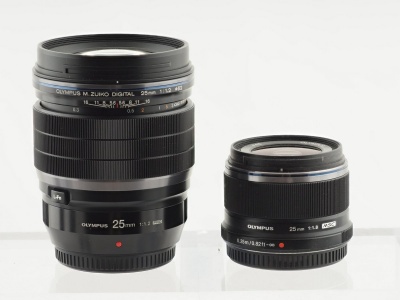
Hier eine kleine Galerie mit Bildern des Objektivs:
Streulichtblende (Schwarz) zum M.ZUIKO DIGITAL 25mm F1.8 - mit freundlicher Genehmigung von team-foto.com
OVP des M.ZUIKO DIGITAL 25mm F1.8 - mit freundlicher Genehmigung von Foto Brell, Frankfurt
Streulichtblende (Silber) zum M.ZUIKO DIGITAL 25mm F1.8 - mit freundlicher Genehmigung von team-foto.com
Streulichtblende (Silber) zum M.ZUIKO DIGITAL 25mm F1.8 - mit freundlicher Genehmigung von team-foto.com
Streulichtblende (Silber) zum M.ZUIKO DIGITAL 25mm F1.8 - mit freundlicher Genehmigung von team-foto.com
Streulichtblende (Silber) zum M.ZUIKO DIGITAL 25mm F1.8 - mit freundlicher Genehmigung von team-foto.com
Linsenschnitt des M.ZUIKO DIGITAL 25mm F1.8 - mit freundlicher Genehmigung von Olympus Deutschland
Alternativen aus dem mFT-Festbrennweiten-Programm
Hier einige weitere Alternativen aus dem mFT-Festbrennweiten-Programm von Olympus, Panasonic, Sigma und Voigtländer (Cosina):
- LEICA DG SUMMILUX 1:1,4/25 ASPH. - etwas lichtstärker (1/2 Blende), sehr gute optische Leistungen, etwas größer und schwerer, teurer
- M.ZUIKO DIGITAL ED 25mm 1:1.2 PRO - etwas lichtstärker (eine Blende), optisch besser, (viel) größer und schwerer, sehr teuer
- Panasonic LUMIX G 25mm F1.7 ASPH. - in allen Belangen mit dem M.ZUIKO DIGITAL 25mm F1.8 vergleichbar - "Gefühlsentscheidung"
- Panasonic LUMIX G 20mm F1.7 ASPH. - kleiner ("Pancake"), optisch etwas besser, soll aber Probleme mit hohen Kontrasten beim Filmen haben (fällt bei Standbildern aber nicht auf)
- Sigma 30mm F1.4 DC DN Contemporary - sehr gute optische Leistungen, sehr groß und schwer (ursprünglich für den APS-C-Bildkreis berechnet), für den "Straßenpreis" eine sehr gute Empfehlung, wenn man mit der Größe leben kann
- Sigma 30mm F2.8 - gute optische Leistungen, sehr gut verarbeitet (insbesondere die "Art-Variante"), aber lichtschwächer, wird (insbesondere gebraucht) sehr preiswert angeboten
- Voigtländer Nokton 25 mm F0.95 - lichtstärker, bei Offenblende etwas "weich", nur manuelle Fokussierung, hervorragend verarbeitet, aber groß und schwer
Tests und Bewertungen
Wertungen bei DXOmark
Zur Einschätzung des Objektivs einige vergleichende Wertungen von DXOmark (jeweils an einer Olympus E-M1 OM-D):
| Objektiv | DxOMark Score | Sharpness | Transmission | Distortion | Vignetting | Chr. aberration |
| LEICA DG SUMMILUX 1:1,4/25 ASPH. | 24 | 11 MP | F1.7 | 1.6% | -1.2EV | 14µm |
| Olympus M.ZUIKO DIGITAL 25mm F1.2 PRO | 23 | 10 MP | F1,6 | 0.2% | -1.2EV | 15µm |
| Olympus M.ZUIKO DIGITAL 25mm F1.8 | ? | ? MP | F?.? | ?.?% | -?.?EV | ?µm |
| Olympus M.ZUIKO DIGITAL ED 30mm F3.5 MACRO | ? | ? MP | F?.? | ?.?% | -?.?EV | ?µm |
| Panasonic LUMIX G 25mm F1.7 ASPH. | 20 | 7 MP | F2.0 | 1.2% | -1.4EV | 19µm |
| Panasonic LUMIX G Macro 30mm F2,8 II ASPH. O.I.S | 19 | 9 MP | F3.1 | 0.4% | -1.2EV | 6µm |
| Sigma 30mm F1.4 DC DN Contemporary | 24 | 10 MP | F1.7 | 0.8% | -0.9EV | 5µm |
| Sigma 30mm F2.8 EX DN | 17 | 8 MP | F3.1 | 0.2% | -0.8EV | 22µm |
| Sigma 30mm F2,8 DN [A] | 18 | 8 MP | F3.1 | 0.3% | -0.7EV | 21µm |
Wertungen bei ephotozine.com
Das Olympus M.ZUIKO DIGITAL 25mm F1.8 wurde in der 2018-er Bestenliste von ephotozine.com geführt: No. 13.
Zitat aus "Holy Trinity - Teil 2: 25mm f/1,2 " in pen-and-tell.de (Vergleichstest der beiden 25mm-Olympus-Objektive)
Ein Zitat aus "Holy Trinity - Teil 1: 45mm f/1,2 " in pen-and-tell.blogspot.de:
- "So doll das bei Porträts kommt – bzw. bei allem, was man freistellen will – wenn mir die Schärfentiefe nicht ausreicht und ich hoffe, dass die Schärfe hinter der Schärfentiefe wenigstens noch hinreichend ist, kann mir da das 25mm, 1,2er ein Bein stellen. Wer also gelegentlich mit 25mm auch mal große Schärfentiefe braucht, sollte sich das durch den Kopf gehen lassen. Ein „One-fits-all“ ist das Objektiv nicht."
Weblinks
- Objektiv bei Olympus Deutschland
- Test bei photozone.de (englisch)
- "Holy Trinity - Teil 2: 25mm f/1,2 " in pen-and-tell.de
- Robin Wong 1 (englisch)
- Robin Wong 2 (englisch)
- Vergleichstest mit dem LEICA DG SUMMILUX 1:1,4/25 ASPH. bei robinwong.blogspot.it (englisch)
- Test bei focus-numerique.com (französisch)
- Review bei slrgear.com (englisch)
- Review bei stevehuffphoto.com (englisch)
- Vergleich M.ZUIKO DIGITAL ED 25mm 1:1.2 PRO <-> M.ZUIKO DIGITAL 25mm F1.8 <-> LEICA DG SUMMILUX 1:1,4/25 ASPH. <-> Voigtländer Nokton 25 mm F0.95 bei lensrentals.com (englisch)


